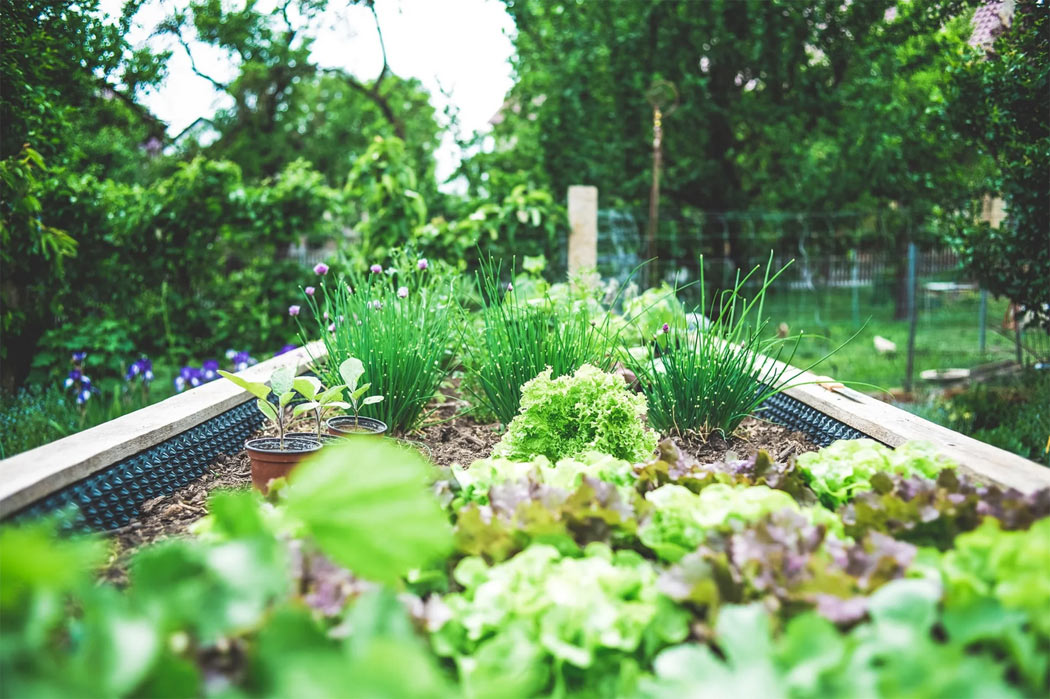Media
 The Efficiency of Home Gardens Compared to Industrial Farms
The Efficiency of Home Gardens Compared to Industrial Farms
Feature in Unsustainable Magazine
There was a time when we all ate produce that was locally grown, even grown by ourselves in our own gardens, but today it is largely industrial farms that are feeding the planet, at least in those countries that are more developed. The average person in these countries might be inclined to believe that we can no longer sustain ourselves by growing our own produce, and that industrial farms are simply more efficient, but is this actually the case? Or can self-sufficiency gardens be just as efficient?

Home Gardens Outshine Industrial Food
By David G Fisher
I’d been gardening off and on—when I wasn’t being a student, sailor, German scholar, or a botany prof in Hawaii—ever since I was about ten. That inner drive to grow resumed in earnest when I moved from Hawaii to Fairfield, Iowa and started up a prodigious little plot of corn, butterbeans, tomatoes, and winter squash. Then two things happened.
First, Covid-19. It triggered me to think, Well, really, everyone should start a garden. Just in case the resulting upset to the food system, with sudden unemployment and long lines at food pantries, began to get serious. So I put my forty years of experience in pure and applied botany into writing a book1 about 21st-century “victory gardens.” Believe it or not, many younger people are unaware of the 20 million gardens that produced some 40 percent of our vegetables during the latter stages of World War Two.
Then the second shoe dropped. To my astonishment, I found that I’d been telling a big lie during my years of teaching college environmental science and sustainability. Namely, that the industrial food system, despite a few nagging problems with pollution and soil erosion, was a marvel of efficiency, precision, and convenience. Every supermarket in the land stocked with thousands of items featuring reliable, just-in-time delivery. What a stupendous accomplishment of modern technology and energy efficiency, rendering the backyard garden a cute but pitiful source of food.
Or so it seemed.
I discovered that despite the scores of gardening books and articles extolling the virtues of bountiful home-grown vegetables, apparently no one had ever thought to comprehensively compare the efficiency—per pound of food produced—of self-sufficiency gardens to the industrial food system. That is, from taste and nutrition to cost, safety, energy consumption, and yield. The shock is that self-sufficiency gardens are not just a little, but vastly more efficient than the industrial system, with far superior health, social, economic, and environmental outcomes.
Now wait just a minute, some will surely protest. Are you kidding? Everyone knows that one farmer with a tractor can do the work of a small army of gardeners with spades. And how could wielding a hoe in the garden possibly be more efficient than simply running out to the grocery store to pick up a few items, bingo, in fifteen minutes?
The Efficiency Advantage of Home Gardens
To begin with, it takes three acres of land for the industrial food system to feed the average American for a year, compared to maybe 5% of that area—or even much less—to feed a person for a year on a balanced diet of garden vegetables. So how is that three acres more efficient?
Right, self-sufficiency gardens will not duplicate the meats, grains, dairy, sweeteners, and soy that make up 85% of the American diet, mostly in the form of ultra-processed, low-nutrition commodities. But those are precisely the foods largely responsible for 70% of the population being overweight—and 40% obese—causing over a third of the country to be either diabetic or prediabetic. Not to mention a host of other food-related problems. How is that efficient?
Even with all that, most of the industrial food system’s inefficiency is due not to using three acres per person but to the gargantuan costs it generates but doesn’t pay for. Various “true cost” studies put these externalities in multiples of $trillions per year:
- $12 trillion of external costs – Food and Land Use Coalition
- $3 trillion per year in environmental costs alone – TruCost study for the UN
- $5 trillion in externalities for U.S. industrial agriculture – Iowa State University
- External costs equal 224% of industrial food’s $1 trillion in revenues – KPMG Global
- $2.6 trillion: cost of wasted food to U.S. economy – Food Fix, Mark Hyman
- At least $3.2 trillion: the true cost of U.S. food – Rockefeller Foundation
- $1.7 trillion: cost of overweight and obesity – Milken Institute
A telling example of externalities is the taxpayer-funded $millions it has taken to build, maintain, and upgrade the nitrate-removal system—the largest in the world—in the Des Moines Waterworks plant. (The toxic nitrate comes from agricultural fertilizer, much of which runs into the rivers.) Not to mention the downstream $millions in damage to the fishing industry in the “dead zone” at the mouth of the Mississippi. Industrial food doesn’t cover those costs. Rather, it foists them off onto other segments of society in the form of huge government subsidies, higher health insurance, environmental damage, and in a long list of other ways.
In other words, the price you pay at the checkout counter is only a fraction of the real cost of your food. By contrast, self-sufficiency gardens generate no such externalities, and very little in the way of up-front costs. When it comes to efficiency, we tend to miss the big picture because we see only small, misleading parts of it like the tractor in a field or the quick trip to the grocery store. But it’s there, it’s real, and it’s killing us.
Garden Super Size Me
Now let’s bring all this home. Remember Morgan Spurlock’s 2004 film “Super Size Me,” in which he ate only at McDonald’s for 30 days, documenting the disastrous results on his body? Well, in 2020 I decided to do a corollary venture, eating only from my garden for a month and recording the weight of everything I consumed. Like Spurlock, I arranged a physical exam before and after the experiment. Unlike him, I emerged healthy, with even a 15-point drop in my cholesterol.
Based on what I ate, and the area it took to grow it, I calculated that I could grow enough to sustain me for a year on a garden of 35’ x 40’, so that’s what I planted in 2021. It was about one percent of the three acres it takes to feed the average American for a year.
As of early November, 2021, I had harvested over a thousand pounds of vegetables, providing more than a year’s worth of three satisfying portions of healthy food per meal, three meals a day. However, I found that to supply enough calories and protein for my BMR (Basic Metabolic Rate) I would have to increase my plantings of energy-dense veggies like corn, beans, and sweet potatoes, and decrease items such as greens, okra, and zucchinis.
Nevertheless, my analysis2 showed that I could accomplish that in the same amount of garden space and at the same yield rates per row foot that I achieved in 2021. Not bad for averaging about an hour of enjoyable activity a day using only hand tools while working with heavy clay soil and a max of only 6 ½ hours of direct sunlight a day. The point is, it’s amazing how much you can grow even if some elements of your gardening endeavor are less than optimal.
What About Everyone Else?
Of course, not everyone is going to rush right out and start a vegetable garden. Yet a third of all U.S. households already have one, and two thirds of adults say they have or are thinking about starting one. Could that include you? Sales of seeds and gardening supplies went through the roof in 2020, as they did again this spring. Meanwhile, last summer you couldn’t find canning supplies anywhere in Fairfield. By contrast, this summer True Value Hardware featured four pallets of canning jars. So it’s clear the gardening train is pulling out of the station.
Still, you may lack a sunny spot for a garden, or live in a city with little or no access to garden space. That’s why I suggest the adoption of a three-tiered food system anchored by home and community gardens, complemented by fresh and processed local foods. Those in turn would be backed up by sustainably reconfigured remnants of more distantly sourced foods. After all, I, like many people, don’t particularly want to give up bananas, cinnamon, croissants, pepper, lemons, cheese, and other such goodies, including some meat products.
Could we realistically get to where at least a third of our food is produced in self-sufficiency gardens, providing a much-needed margin of safety against raging climate change disasters and the nearly 20% of our country that’s food insecure? Before you answer, think again about those 20 million victory gardens churning out 40% of our vegetables in WWII. Add in the fact that self-sufficiency gardeners in Nigeria, with a fraction of our resources, produce 50% of their country’s vegetables on just 2% of its agricultural land. And consider that 80% of Americans have lawns, the average of which could grow six gardens the size of mine.
Then ask yourself: Why not?
1Just Grow It Yourself – Home Gardens Outshine Industrial Food
